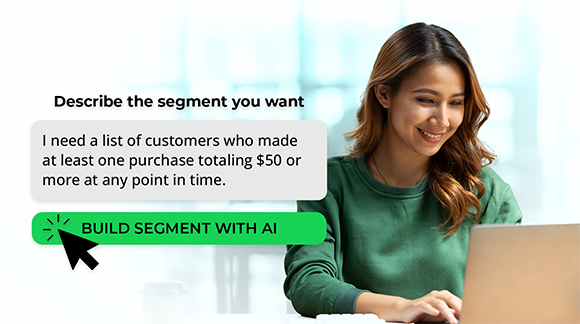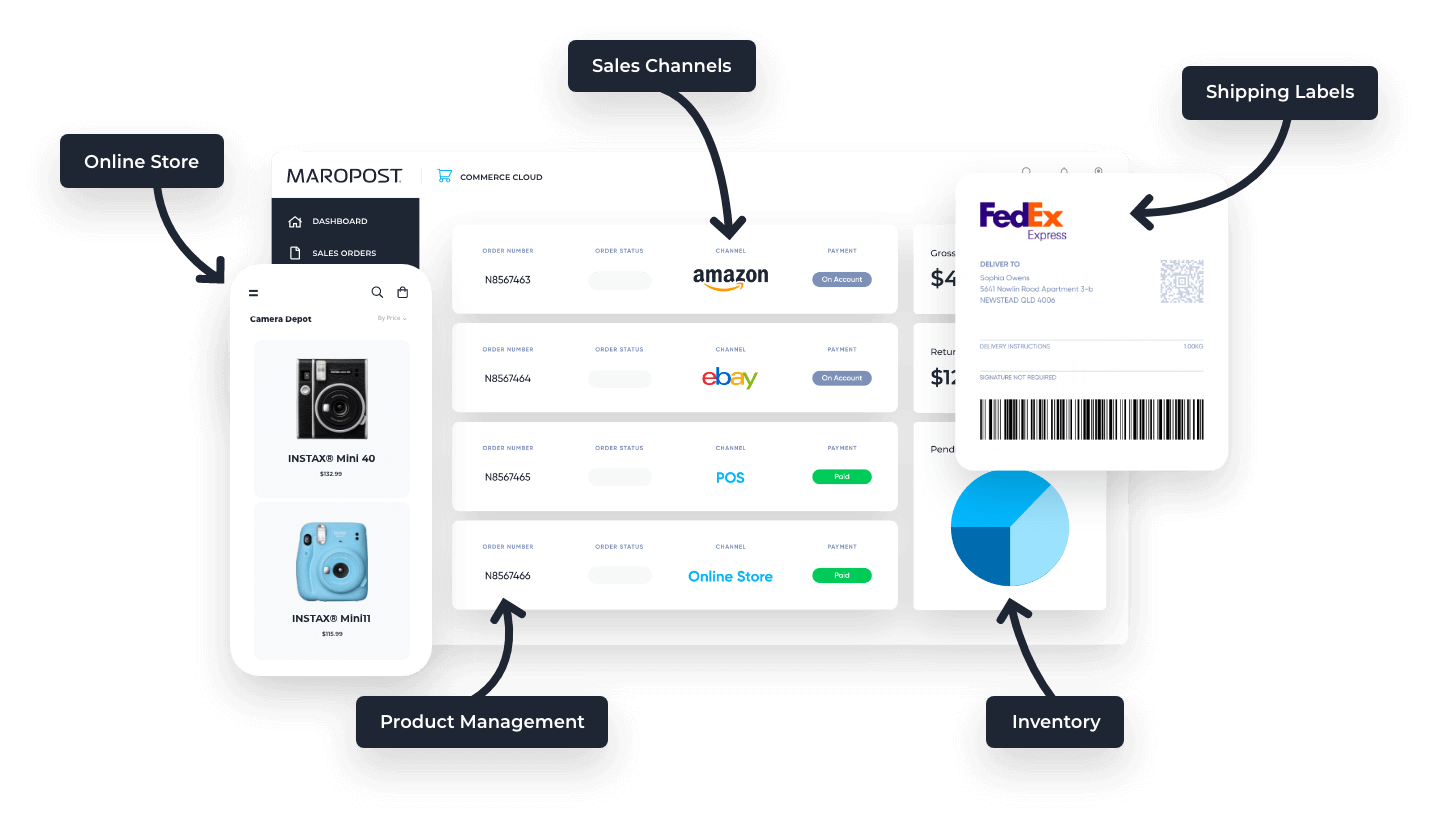If you’ve ever tried sending automated generic emails to your customers, you’ve probably noticed that these emails often go unopened or get marked as spam. Research shows that personalized emails have an 82% higher open rate and a 52% increase in sales compared to generic emails. But, automating personalization is hard, so many marketers turn to crafting individual emails, personalizing them with “Hi [first name]” and waiting for the magic to happen while burning themselves out.
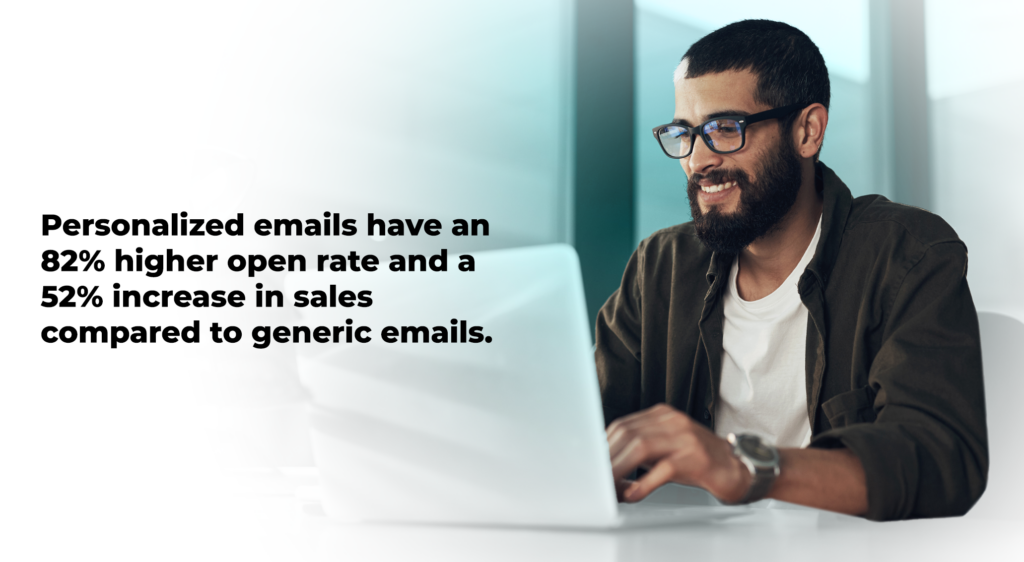
A better strategy is to use audience segmentation to help automate personalization at scale. The results speak for themselves: Segmented email marketing campaigns have also been shown to drive a 760% increase in revenue.
Plus, there are ways to automate audience segmentation using AI-powered tools like natural language processing (NLP). This allows you to maximize engagement and conversions by delivering personalized email campaigns and content to each audience segment without burning out.
- What is audience segmentation?
- Why is audience segmentation important?
- How to simplify and speed audience segmentation
- Benefits of NLP in email segmentation
- Speed audience segmentation with ready-to-use NLP prompts
- Strategies for crafting personalized email content
What is audience segmentation?
If you don’t segment your email list, you’ll have one giant list. However, every contact in your list is different and will likely respond to different types of marketing and emails. So, it’s better to break your email list into segments. To optimize your email marketing campaigns, you’ll want to create multiple segments of your email list based on various criteria such as geographic location, interests, email engagement, and purchase history. This is known as audience segmentation.
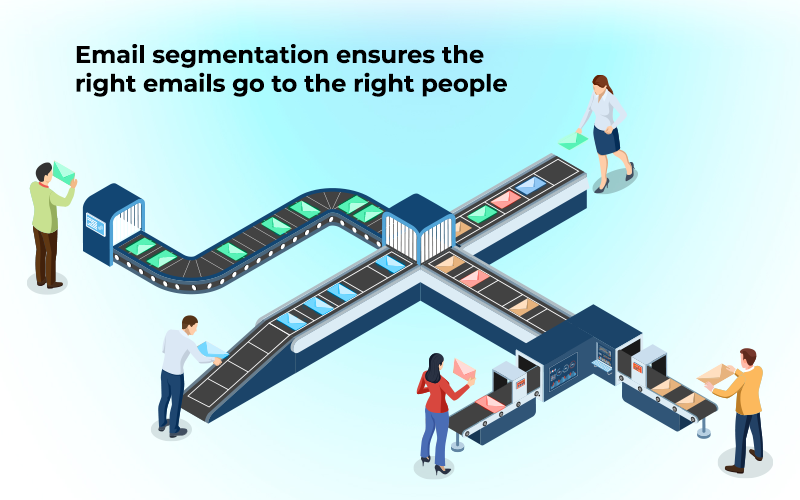
Why is audience segmentation important?
Audience segmentation is crucial for improving the performance of email marketing campaigns because it allows you to tailor your messages to specific groups with similar interests. By segmenting your email list based on criteria such as geographic location, interests, purchase history, and engagement levels, you can send more personalized and relevant content to each segment. This targeted approach increases the likelihood that recipients will find the content valuable, leading to higher open and click-through rates, and ultimately, greater conversion rates.
For instance, consider a retail business that sends a single, generic email about a winter coat sale to its entire customer base. However, over half of its customers live in climates where it doesn’t get cold enough to need winter coats. This one-size-fits-all approach often results in low engagement, as the content isn’t relevant to a large portion of the audience.
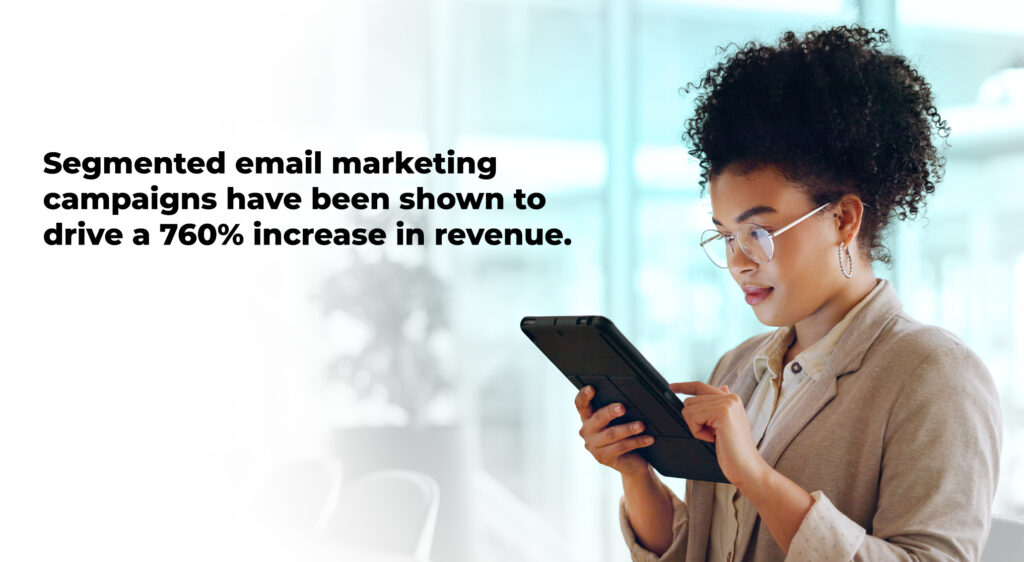
Customers may become frustrated with receiving irrelevant emails, leading to higher unsubscribe rates and a diminished brand perception. In contrast, by segmenting the audience, the retailer can send tailored offers to different segments.
For example, you could promote winter clothing to customers in colder climates and summer apparel to those in warmer regions. This personalization not only enhances the customer experience by delivering content that meets their needs and preferences but also boosts the email campaign’s effectiveness, driving higher engagement and sales.
How to simplify and speed audience segmentation
So you know audience segmentation is an important part of your email marketing campaign strategy, but how do you segment your email list?
Traditional segment builders require marketers to manually set criteria based on customer behavior, demographics, and other factors, often involving complex rule builders. However, if you use AI-powered segment builders with natural language processing (NLP) capabilities, you can streamline this process because it allows you to define or query segments using plain, natural language.
In other words, instead of manually toggling between different demographic, psychographic, or geographic characteristics, you just ask for what you want.
You may not realize it, but you probably already use NLPs every day, such as when you ask Alexa to order paper towels, use predictive text, or message customer service chatbots.
Overview of natural language processing in audience segmentation
The goal of NLP, which uses AI, is to enable computers to understand, interpret, and generate human language in a way that is both meaningful and useful. With NLP-enhanced segment builders, marketers can create audience segments without the need for manual rule-building. The user-friendly interface allows criteria to be entered as simple sentences, such as “give me people who purchased a shirt in the last six months.”
NLP can help you segment your audience using text analysis techniques such as topic modeling, sentiment analysis, or keyword extraction. For example, you can use topic modeling to identify the main themes or categories in your email list and then create segments based on those topics.

\
Generating segments with pre-defined prompts
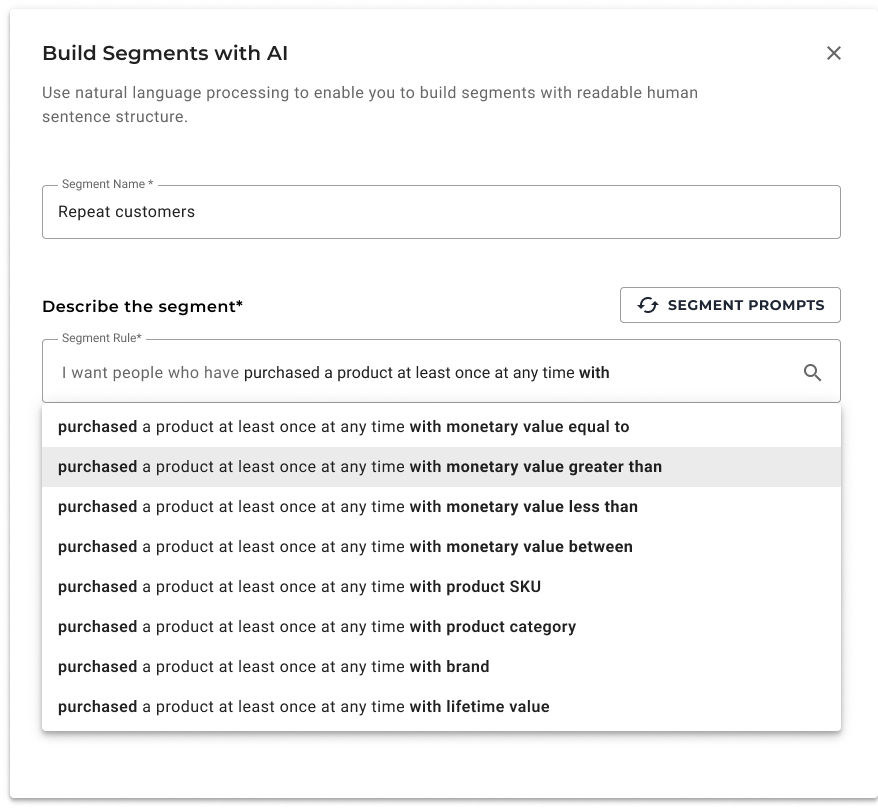
Additionally, pre-defined sentences tailored for common marketing needs speed up segment creation. Users can instantly preview the criteria and subscriber results generated by their NLP inputs, ensuring accuracy before finalizing the segment. This innovation not only makes segmentation more accessible but also significantly enhances the efficiency and effectiveness of email marketing campaigns.
To get the most from an AI-powered segmentation builder, gather comprehensive and accurate data about your email subscribers. This includes demographic information, purchase history, engagement metrics, and any other relevant details that can inform your segmentation strategy.
Benefits of AI in audience segmentation
By eliminating the need for technical expertise with rule builders and logical operators, tools like Maropost’s AI-powered Segment Builder democratizes the segment creation process, making it accessible to marketers of all skill levels. With the ability to generate precise audience segments using natural language prompts, marketers can quickly and easily define their target groups, streamlining the entire segmentation process.
One of the most notable advantages of an NLP segmentation builder is the significant time savings it provides. Almost a quarter of marketers say building segments with NLP reduces creation time compared to traditional methods.
This efficiency not only allows marketers to focus more on strategic planning and less on operational tasks, it also speeds up the setup process while ensuring that campaigns are targeting the most impactful segments, thereby improving deliverability and boosting relevance and effectiveness. Ultimately, a segmentation builder with NLP baked in enhances the overall performance of email marketing campaigns by enabling more precise and efficient audience segmentation.
Speed email segmentation with ready-to-use NLP prompts
Using predefined prompts, an NLP segmentation builder can help you quickly identify and target key customer segments. These ready-to-use prompts eliminate the need for complex manual setups, making segmentation faster and more efficient.
Here are some examples of predefined prompts for common segmentation goals. Feel free to borrow these examples or create your own:
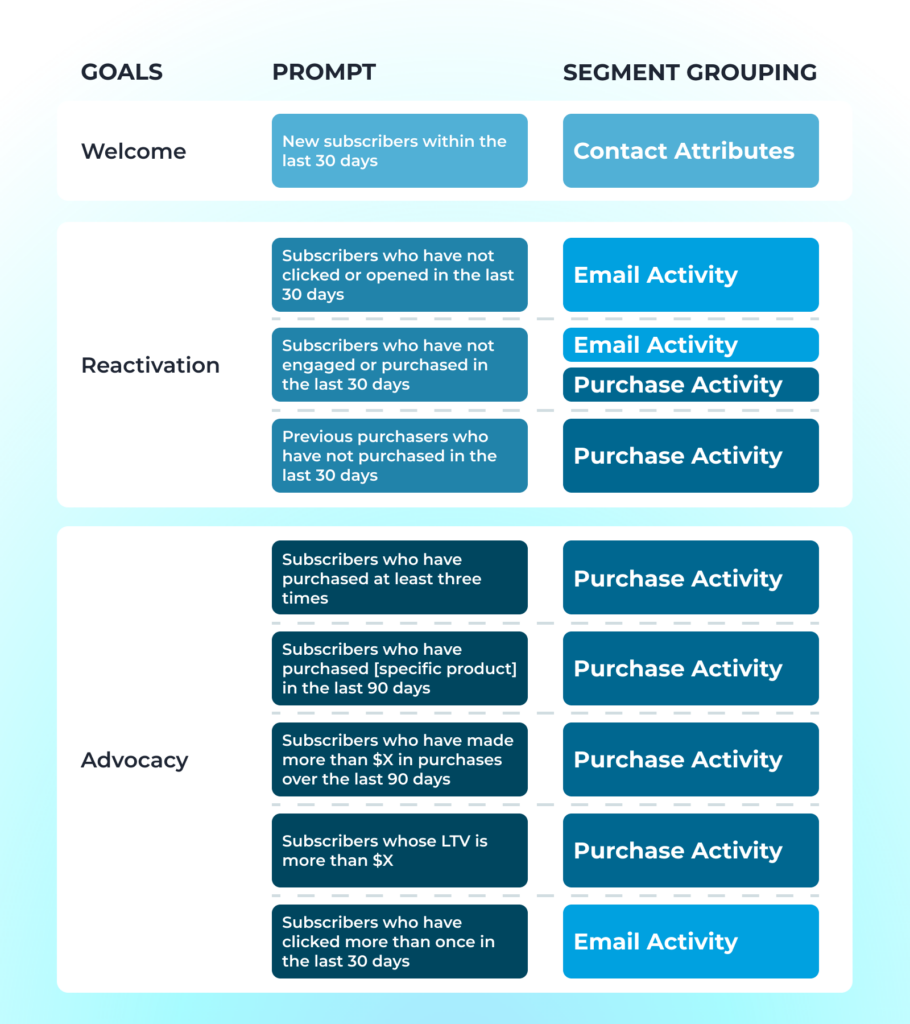
Use cases for NLP prompts
NLP prompts offer versatile applications in email segmentation, allowing marketers to quickly and efficiently create targeted campaigns. Here are some specific use cases for using NLP prompts:
Use case #1: Segment based on contact attributes
NLP prompts can quickly create segments based on contact attributes such as name, demographics (age, gender, location), and custom fields in the contacts table.
Example: A campaign can be specifically designed for “people aged 40-55 in Oklahoma,” targeting them with relevant promotions such as skin care products or local wellness events. Promotions can also include seasonal offers, such as summer skincare routines and winter wellness tips, ensuring the campaign stays relevant year-round.
Use case #2: Target based on buying behaviors
NLP prompts also enable segmentation based on buying behaviors, including the last purchase date, products purchased, and total monetary value of purchases.
Example: For subscribers who purchased a particular digital camera, the campaign might suggest complementary products (e.g., camera bags and memory cards). The campaign can also offer bundled deals and exclusive discounts on these accessories, along with tutorials or workshops on getting the most out of their new camera.
Strategies for crafting personalized email content
Crafting personalized email content is essential for driving conversions. Make your email copy friendly and personable, avoid jargon, and employ humor where appropriate. Tailor your content to be relevant and valuable to your subscribers, ensuring they look forward to your emails.
You can also use audience segmentation tactics to personalize your emails at scale:
Target campaigns
Targeting specific groups of contacts allows you to tailor your messages to their unique needs and preferences. For instance, segment your audience by demographics, such as “people aged 40-55 in Colorado,” and send them promotions for mountain bike equipment or local bike repair clinics.
Suppress contacts from campaigns
In re-engagement campaigns, suppress your more active contacts to focus on inactive users. This ensures that your efforts are directed toward subscribers who need a nudge, improving overall campaign efficiency.
Dynamic content
Dynamic content allows different segments of your audience to see different promotion details based on their location or other attributes. For example, contacts in different regions can receive tailored offers that are more relevant to them.
Trigger journeys
Use NLP-driven segment builders to create triggers for automated journeys. Triggered emails, sent based on specific subscriber actions, add a personal touch to your communications. Examples include welcome emails, reminders, and lead nurturing emails.
Filters within journeys
Implement filters within your email journeys to customize the path for different contacts. For instance, contacts who purchase a product can receive a thank-you email to end the journey, while those who don’t make a purchase continue to receive promotional emails.
Send emails from a person
Personalize your emails by sending them from a real person rather than a business. Emails from a person are more likely to be trusted and opened. Using a real person’s name and face instead of a logo can significantly increase your click-through rates and overall engagement.
Use important anniversaries
Celebrate important anniversaries, such as your subscribers’ birthdays or the anniversary of their first purchases. Acknowledging these dates creates a personal connection and encourages subscribers to engage more with your emails and promotions.
Maximize email marketing success with segmentation and NLP
AI-powered tools like NLP segmentation builders can automate the email segmentation process, enabling you to maximize engagement and conversions without burning out. By delivering personalized email campaigns and content to each segment of your audience, you can significantly enhance the effectiveness of your email marketing strategy. Embrace segmentation to ensure your emails are relevant, engaging, and impactful, ultimately driving better results for your business.
Want to see AI-powered audience segmentation in action? Book a demo of Maropost Marketing Cloud.
Need to chat about your mobile marketing strategy?
More than 10,000 marketers use Maropost to engage with their prospects and customers through emails, SMS, social media and more. We’re here to help you grow your business!
Chat Now
